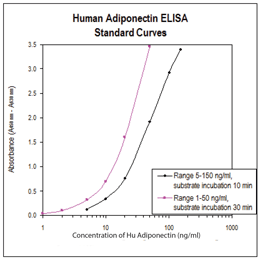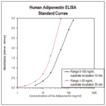Minimum Order Quantity: 10
-
Rapid – results in just 3 hours from up to 38 samples in duplicate
-
Quantitative – fully quantitative results surpass semi-quantitative Western blot analysis
-
Sensitive – measure as little as 0.1 ng/ml of adiponectin
The Adiponectin (human), ELISA kit is a colorimetric, immunometric immunoassay kit with results in <3 hours.
Please mouse over
Product Details
| Alternative Name: | ACRP30, ADIPOQ, GBP28, Adipocyte C1q and collagen domain-containing protein, Adipocyte complement-related 30 kDa protein, Gelatin-binding protein, ACDC, APM1 |
| |
| Sensitivity: | 0.156ng/ml (CSF, urine); 0.47ng/ml (plasma, serum) (range 1 to 150ng/ml) |
| |
| Assay Time: | <3 hours |
| |
| Applications: | ELISA, Colorimetric detection
|
| |
| Application Notes: | For quantitative determination of human adiponectin in cerebrospinal fluid, plasma, serum, urine and (breast) milk. |
| |
| Wavelength: | 450 nm |
| |
| Species reactivity: | Human
|
| |
| Crossreactivity: | No cross-reactivity has been observed for human leptin, leptin receptor and resistin at 100ng/ml. Species cross-reactivities includes cat, dog, hamster, monkey, and rat adiponectin. |
| |
| Shipping: | Blue Ice |
| |
| Long Term Storage: | +4°C |
| |
| Contents: | Microtiter Plate, Conjugate, Standards, Quality Controls, Dilution Buffer Concentrate, Substrate Solution, Stop Solution, Wash Buffer Concentrate |
| |
| Scientific Background: | Adiponectin, also referred to as Acrp30, AdipoQ and GBP-28, is a 244 amino acid protein, the product of the apM1 gene, which is physiologically active and specifically and highly expressed in adipose cells. The protein belongs to the soluble defence collagen superfamily; it has a collagen-like domain structurally homologous with collagen VIII and X and complement factor C1q-like globular domain. Adiponectin forms homotrimers, which are the building blocks for higher order complexes found circulating in serum. Together, these complexes make up approximately 0.01% of total serum protein. Adiponectin receptors AdipoR1 and AdipoR2 have been recently cloned; AdipoR1 is abundantly expressed in skeletal muscle, whereas AdipoR2 is predominantly expressed in the liver. Paradoxically, adipose tissue-expressed adiponectin levels are inversely related to the degree of adiposity. Adiponectin concentrations correlate negatively with glucose, insulin, triglyceride concentrations, liver fat content and body mass index and positively with high-density lipoprotein-cholesterol levels, hepatic insulin sensitivity and insulin-stimulated glucose disposal. Adiponectin has been shown to increase insulin sensitivity and decrease plasma glucose by increasing tissue fat oxidation. |
| |
| UniProt ID: | Q15848 |
| |
| Regulatory Status: | RUO - Research Use Only |
| |
| Compatibility: | This product is compatible with the Absorbance 96 Plate Reader.
 |
| |
Product Literature References
Impact of arsenic exposure on clinical biomarkers indicative of cardiovascular disease risk in Mexican women: Á.C. Ochoa-Martínez, et al.; Ecotoxicol. Environ. Saf.
169, 678 (2019),
Application(s): ELISA of human serum,
Abstract;
Association of adiponectin with cognitive function precedes overt diabetes in the Brazilian Longitudinal Study of Adult Health: ELSA: A. Cezaretto, et al.; Diabetol. Metab. Syndr.
10, 54 (2018),
Abstract;
Full Text
Neck circumference is associated with non-traditional cardiovascular risk factors in individuals at low-to-moderate cardiovascular risk: cross-sectional analysis of the Brazilian Longitudinal Study of Adult Health (ELSA-Brasil): B. Almeida-Pititto, et al.; Diabetol. Metab. Syndr.
10, 82 (2018),
Abstract;
Full Text
Serum Concentrations of New Predictive Cardiovascular Disease Biomarkers in Mexican Women Exposed to Lead: Á.C. Ochoa-Martínez, et al.; Arch. Environ. Contam. Toxicol.
74, 248 (2018),
Application(s): ELISA of human serum,
Abstract;
Long-term feeding of red algae (Gelidium amansii) ameliorates glucose and lipid metabolism in a high fructose diet-impaired glucose tolerance rat model: H.C. Liu, et al.; J. Food Drug Anal.
25, 543 (2016),
Application(s): Determination of plasma adiponectin in rats,
Abstract;
Therapeutic role of ursolic acid on ameliorating hepatic steatosis and improving metabolic disorders in high-fat diet-induced non-alcoholic fatty liver disease rats: S. Li, et al.; PLoS One
9, e86724 (2014),
Application(s): ELISA using rat serum,
Abstract;
Full Text
Related Products














